Central California
-
- Our Third Century Maritime Reporter, Jul 1990 #34
Admiral J.W. Kime, Commandant, United States Coast Guard Editor's Note: Mm. John William Kime was recently named the 19th Commandant of the U.S. Coast Guard. He was nominated to the position while serving as Commander, Eleventh Coast Guard District, headquartered in Long Beach, Calif.
During that time he also served as the Commander of the Central California Sector of the U.S. Maritime Defense Zone, Pacific; and as Coordinator of the Pacific Region of the Pacific Region of the Office of National Drug Control Policy.
As the United States Coast Guard enters a third century of service to Americans, our future is as bright as it is challenging. Our anthem has a line that sums up our existence: "Semper Paratus (always ready) is our call." For two centuries of service, we have lived up to that goal.
Last year saw us answer the call many times. We answered the call from mariners in need of help 60,000 times. We answered the call to battle drug smugglers, and seized almost 33,000 pounds of cocaine and a quarter million pounds of marijuana.
Whether it was destruction by hurricanes like Hugo, or earthquakes in San Francisco, Coast Guard men and women were there to help.
Just as we tried to save people from the environment, so we tried to save the environment from people.
Large oil spills received national attention. But we also answered the call to another 8,000 oil and chemical spills last year. Large or small, the Coast Guard responded and did what we could. We can take pride in our accomplishments, but they are in the past.
Today we are working hard. Our men and women are knowledgeable and dedicated. Where do we go from here? Our watchword as we enter our third century must be balance.
We must recognize that all of our operational missions are equally important.
We cannot forget our humanitarian tradition. We are first and foremost "the lifesavers." Our roots are found in the brave men and women who risked their lives so that others might live. Our technology will change, but our commitment to saving lives and property will not.
Our leadership in maritime law enforcement is well established. Unfortunately, drugs will continue to plague the nation as the Coast Guard enters its third century. Fisheries are growing in importance, and that will continue. Our role in these missions will continue to grow, and we will continue to build partnerships with the Office of National Drug Control Policy, Department of Defense, Customs Service, Drug Enforcement Administration, and National Marine Fisheries Service.
In the mid-1980s we assembled the right mix of interdiction re resources and virtually shut down large shipments of marijuana across the Caribbean. We went from two or three motherships a week, with 20- 40-ton loads, to one or two ships a month, with 5 to 10-ton loads.
In the last 8-12 months, we have seen a dramatic decline in cocaine shipments across the Caribbean. Increased pressure in Colombia, increased Department of Defense resources have made the difference.
We wholeheartedly welcome the other armed services into this effort.
We have not won the war on drugs.
But we are winning an important battle. We need to keep the pressure on the Caribbean, and be ready as the smugglers shift to new methods.
In the future, the environment will take on greater importance for the nation and the Coast Guard. We must maintain our leadership role in both the national and international areas. We will improve our oil spill response capability. But we must also improve our ability to prevent spills. Equal parts of the balance must be operational readiness and regulatory prevention. Keep the oil in the ship if we can, but answer the call to clean it up if it gets out.
The Coast Guard needs to recognize the balance between operational and support functions. The pilots cannot fly to a rescue, the boat crews cannot search for drugs, and oil won't get cleaned up if the spare parts aren't ordered, the paperwork isn't completed, and the lawyers don't dot the "I's" and cross the "T's." Both elements need to be done right if we are to answer the call.
A good example of mission balance is the design of our new seagoing buoy tenders. The present fleet of 180-foot buoy tenders are all approaching 50 years of service—a good return on the taxpayers' dollars— but now the costs of maintenance and repair are getting prohibitive.
These ships need to be replaced.
Our engineers are working on a design for an oil-skimming capability. For the first time, this will provide the United States with an open-ocean skimming capability.
These vessels will be scattered in ports around the country and put to work servicing aids to navigation.
When an oil spill occurs, they can respond instantly to begin a cleanup operation. They will be an important segment in the joint effort to protect our environment.
As this is being written, Congress is in conference formalizing an oil spill bill. The final form is yet unknown, but both the House and Senate versions contain increased responsibilities for the Coast Guard.
More strike teams are needed to respond to spills. More vessel traffic systems are also required to prevent spills. Funding for equipment and personnel will need to be addressed, but it seems certain some form of this legislation will pass and be signed into law.
Our sister military services have been our partners in war and peace for many years. If changes in Europe cause the United States to draw down troop levels overseas, the importance of military sealift capability will grow. That means the Coast Guard's roles in port security and the maritime defense zone will remain part of our balance. As we have for our first two centuries, we will remain flexible and adapt to changing requirements.
Drug interdiction, maritime safety, environmental protection, and national security are all important, but the most important element we need for balance is people. We ask a great deal of our Coast Guard men and women. They willingly go into harms' way for the good of others.
They spend long hours serving their country, often separated from home and family for extended periods.
Taking proper care of them is the top responsibility for their Commandant.
Most Coast Guard stations are small, 20-25 people. Many are in areas with no big military bases nearby, no commissaries or military hospitals. Most of our people don't have access to military housing.
They are often stationed in resort areas because that is where the work is. But that is also an expensive place for a young seaman or petty officer to rent housing. We ask so much of them, we must ensure they get adequate housing and medical care. We must balance our operational needs with the needs of the people who answer our operation calls.
As we enter our third century, I see a strong Coast Guard with strong men and women carrying out vital missions. The future looks good. As always, there are challenges to be met and changes to be made. We have answered the call for two hundred years. The young men and women I have met throughout today's Coast Guard are our future, and they will uphold the great traditions of those who have gone before them.
-
 )
March 2024 - Marine Technology Reporter page: 19
)
March 2024 - Marine Technology Reporter page: 19for cloud-based online reporting and visualization, FORCE Tech- pipelines/Potential distribution plot for 3D structures to iden- nology can provide a central portal for information on all CP tify hotspots/areas of under-protection, Anode current output at an entire development or even multiple developments
-
 )
April 2024 - Maritime Reporter and Engineering News page: 38
)
April 2024 - Maritime Reporter and Engineering News page: 38for scheduled delivery from South Korea’s Hyundai Mipo Dockyard in 2025. EPS will charter the ships out to Crowley, who will deploy them on its U.S.-Central America trade connecting U.S. markets to Nicaragua, Hon- duras, Guatemala and El Salvador. Each ship will feature 300 Image courtesy HRDD refrigerated
-
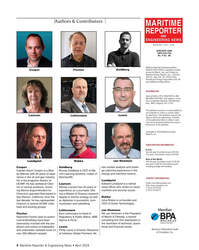 )
April 2024 - Maritime Reporter and Engineering News page: 4
)
April 2024 - Maritime Reporter and Engineering News page: 4Authors & Contributors MARITIME REPORTER AND ENGINEERING NEWS M A R I N E L I N K . C O M ISSN-0025-3448 USPS-016-750 No. 4 Vol. 86 Maritime Reporter/Engineering News (ISSN # 0025-3448) is published monthly Cooper Fischer Goldberg except for March, July, and October by Maritime Activity Reports, Inc.
-
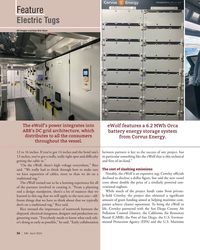 )
April 2024 - Marine News page: 34
)
April 2024 - Marine News page: 34Feature Electric Tugs All images courtesy Eric Haun The eWolf’s power integrates into eWolf features a 6.2 MWh Orca ABB’s DC grid architecture, which battery energy storage system distributes to all the consumers from Corvus Energy. throughout the vessel. 12 to 16 inches. If you’ve got 14 inches and
-
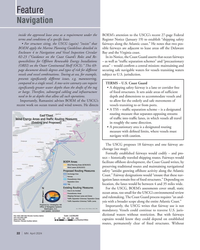 )
April 2024 - Marine News page: 22
)
April 2024 - Marine News page: 22– as well as “traf? c separation schemes” and “precautionary (OREI) on the Outer Continental Shelf (OCS).” This 69- areas” – would con? rm a central mission: maintaining and page document details degrees and types of risk for different securing safe navigable waters for vessels transiting waters
-
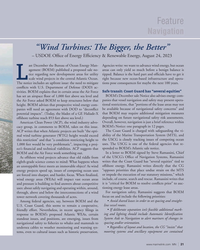 )
April 2024 - Marine News page: 21
)
April 2024 - Marine News page: 21balance is tice regarding new development areas for utility tipped. Balance is the hard part and of? cials have to get it L scale wind projects in the central Atlantic Ocean. right because new ocean-based infrastructure and opera- The notice includes an upfront issue: the need to mitigate tions pose consequence
-
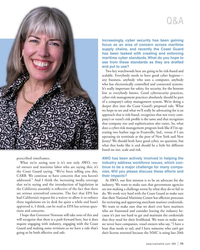 )
April 2024 - Marine News page: 11
)
April 2024 - Marine News page: 11Q&A Increasingly, cyber security has been gaining focus as an area of concern across maritime supply chains, and recently the Coast Guard has been tasked with creating and enforcing maritime cyber standards. What do you hope to see from these standards as they are drafted and put to use? Two key
-
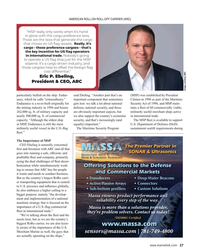 )
February 2024 - Maritime Reporter and Engineering News page: 27
)
February 2024 - Maritime Reporter and Engineering News page: 27to ensure that ARC has the people it wants and needs to conduct business. But as the country’s largest RoRo carri- er transporting equipment that is central to U.S. presence and in? uence globally, he also embraces a higher calling to a bigger purpose; namely “the develop- ment and implementation of
-
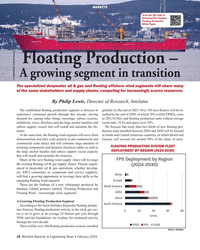 )
February 2024 - Maritime Reporter and Engineering News page: 18
)
February 2024 - Maritime Reporter and Engineering News page: 18pro- ments. duction units installed between 2024 and 2030 will be located At the same time, the ? oating wind segment will move from in South and Central American countries, of which Brazil and demonstration and pilot scale projects to pre-commercial and Guyana will account for around 90% of the share
-
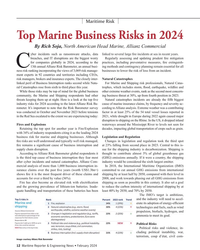 )
February 2024 - Maritime Reporter and Engineering News page: 12
)
February 2024 - Maritime Reporter and Engineering News page: 12legislation and regulation took the third spot ? re remains a signi? cant cause of business interruption and at 23% falling from second place in 2023. Central to this is- supply chain disruption. sue for the shipping industry is decarbonization. Shipping is According to Allianz Risk Barometer global respondents
-
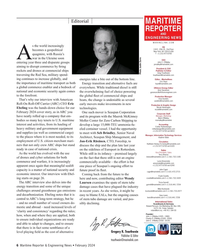 )
February 2024 - Maritime Reporter and Engineering News page: 6
)
February 2024 - Maritime Reporter and Engineering News page: 6.733.2477 and decarbonization. Ebeling notes that it is easy to blame EALs, but the ongoing causes Gary Lewis [email protected] | +1.516.441.7258 central to ARC’s long-term strategy, but he of stern tube damage are varied, and pos- International Sales – and no small number of vessel owners do- sibly
-
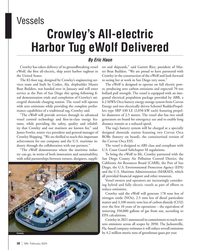 )
February 2024 - Marine News page: 38
)
February 2024 - Marine News page: 38Vessels Crowley’s All-electric Harbor Tug eWolf Delivered By Eric Haun Crowley has taken delivery of its groundbreaking vessel ers and shipyards,” said Garrett Rice, president of Mas- eWolf, the ? rst all-electric, ship assist harbor tugboat in ter Boat Builders. “We are proud to have partnered with the
-
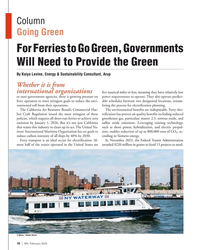 )
February 2024 - Marine News page: 16
)
February 2024 - Marine News page: 16Column Going Green For Ferries to Go Green, Governments Will Need to Provide the Green By Kaiya Levine, Energy & Sustainability Consultant, Arup Whether it is from international organizations ? ve nautical miles or less, meaning they have relatively low or state government agencies, there is growing
-
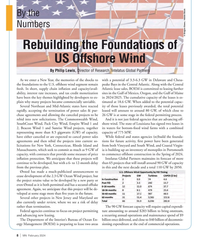 )
February 2024 - Marine News page: 8
)
February 2024 - Marine News page: 8of the shocks to with a potential of 3.3-6.3 GW in Delaware and Chesa- the foundations to the U.S. offshore wind segment remain peake Bays in the Central Atlantic. Along with the Central fresh. In short, supply chain in? ation and capacity/avail- Atlantic lease sales, BOEM is committed to leasing further
-
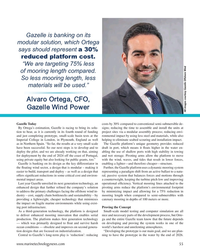 )
January 2024 - Marine Technology Reporter page: 55
)
January 2024 - Marine Technology Reporter page: 55harshest and unrelenting atmospheres. tion designs that are focused on industrialization. “Developing the prototype is our main goal, and we are plan- Central to Gazelle’s long-term play is ‘reduction’: reducing ning to have the prototype in the water by the end of 2026. www.marinetechnologynews.com 55 MTR
-
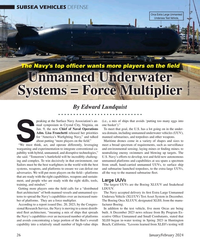 )
January 2024 - Marine Technology Reporter page: 26
)
January 2024 - Marine Technology Reporter page: 26SUBSEA VEHICLES DEFENSE Orca Extra Large Unmanned Undersea Test Vehicle. The Navy’s top of? cer wants more players on the ? eld Unmanned Underwater Systems = Force Multiplier Source: Boeing By Edward Lundquist peaking at the Surface Navy Association’s an- (i.e., a mix of ships that avoids ‘putting too
-
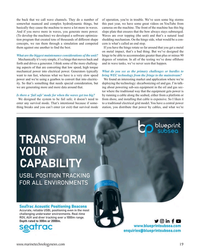 )
January 2024 - Marine Technology Reporter page: 19
)
January 2024 - Marine Technology Reporter page: 19that cable is expensive. So I liken it enter any survival mode. That’s intentional because if some- to a traditional electrical grid model. You have a central power thing breaks and you can’t enter (or exit) that survival mode station, you distribute that power by cables, and what we’re www.marinetechnologynew
-
 )
January 2024 - Marine Technology Reporter page: 16
)
January 2024 - Marine Technology Reporter page: 16to life in the operation- el of ships plus autonomous systems, to one where autonomy is al world by the MFP. Software which is designed to deliver central. With the scaling up of autonomy, the project management complex projects from start to ? nish, all encompassed under is a key part in facilitating
-
 )
January 2024 - Marine Technology Reporter page: 14
)
January 2024 - Marine Technology Reporter page: 14to enable a diverse for Sea Research (NIOZ) and MAAS software engineering. This range of scienti? c research. National Marine Facilities (NMF) central web-based portal captures each request for ship time, is the largest department in NOC, with 190 employees; the equipment and handles all the contributin
-
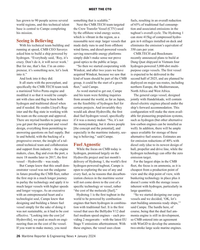 )
January 2024 - Maritime Reporter and Engineering News page: 26
)
January 2024 - Maritime Reporter and Engineering News page: 26, resulting in an overall reduction world regions, and this technical talent Next the CMB.TECH team targeted of 65% of traditional fuel consump- base is central to Campe completing the Crew Transfer Vessel (CTV) used tion and associated emissions in the his mission. by the offshore wind energy sector,
-
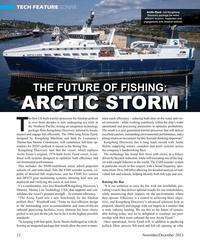 )
November 2023 - Marine Technology Reporter page: 22
)
November 2023 - Marine Technology Reporter page: 22? ciency. while minimizing their impacts on the environments where “The Arctic Fjord sets a new benchmark for the Alaskan they operate. Ef? ciency is a central to achieving those objec- pollock ? eet,” Woodruff said. “From its fuel-ef? cient design tives, and Kongsberg Discovery’s advanced solutions help
-
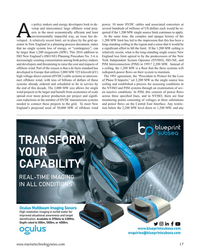 )
November 2023 - Marine Technology Reporter page: 17
)
November 2023 - Marine Technology Reporter page: 17systems monitoring points consisting of voltages at three substations needed to connect these projects to the grid. To meet New and power ? ows on the Central East Interface. Any restric- England’s projected need of 30,000 MW of offshore wind tion below the 2,200 MW level down to 1,200 MW, and any www
-
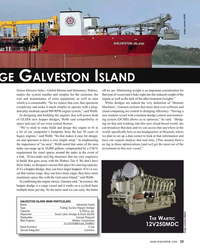 )
December 2023 - Maritime Reporter and Engineering News page: 33
)
December 2023 - Maritime Reporter and Engineering News page: 33with a plug- Machines’, Gunsten reckons that more than ever software and and-play medium speed 900 RPM engine system,” said Webb. cloud computing are central to dredging ef? ciency. “Having a In designing and building the engines that will power both new modern vessel with a modern dredge control and
-
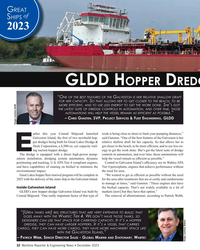 )
December 2023 - Maritime Reporter and Engineering News page: 32
)
December 2023 - Maritime Reporter and Engineering News page: 32, dredging system automation, dynamic help the vessel remain as ef? cient as possible.” positioning and tracking, U.S. EPA Tier 4 compliant engines, Central to Galveston Island’s ef? ciency are its Wabtec EPA and have capabilities of running on biofuel to minimize the Tier 4 powerplants, engines that
